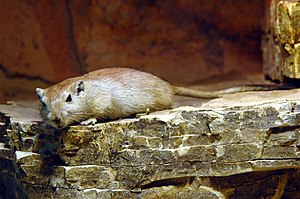Sand rats
| Sand rats | ||||||||||||
|---|---|---|---|---|---|---|---|---|---|---|---|---|

Fat sand rat ( Psammomys obesus ) |
||||||||||||
| Systematics | ||||||||||||
|
||||||||||||
| Scientific name | ||||||||||||
| Psammomys | ||||||||||||
| Cretzschmar , 1828 |
Sand rats ( Psammomys ) are a rodent genus within the subfamily gerbils .
There are two kinds.
- The fat sand rat ( Psammomys obesus ) lives in several separate regions in northern Africa and western Asia. The distribution area extends from Mauritania to Syria and Saudi Arabia . The IUCN lists the species as not endangered ( least concern ).
- The slender sand rat ( Psammomys vexillaris ) inhabits Algeria , Libya and Tunisia . It is listed with "insufficient data" ( data deficient ).
features
Sand rats are similar to other gerbils in their physique. The fur color on the top varies between red-brown, yellow-brown and sand-colored. The stomach and legs are more yellowish. These rodents reach a head-trunk length of 13 to 18.5 cm and a tail length of 11 to 15 cm. The weight of the fat sand rat is 80 to 200 grams. There is a small tassel at the end of the tail. Differences to the actual racing rats consist in the only 10 to 15 mm long rounded ears and in the structure of the teeth.
Way of life
These gerbils live in dry habitats such as sandy deserts , semi-deserts, areas with grass or bush vegetation or in rocky areas. They dig complex underground structures with multiple tunnels and chambers. Sand rats are often seen sitting on their hind legs at the entrance to the burrow. The food probably consists mainly of foxtail plants . These plants often store a great deal of salt , which the sand rats excrete with the help of their very effective kidneys. Sand rats sometimes eat crops, which is why some farmers consider them pests.
Females can presumably mate year round. The gestation lasts under favorable circumstances about 25 days and can last about 35 days at a lack of food. Two to five young are born per litter and suckled for about three weeks. Females in laboratory housing were sexually mature after three months at the earliest.
literature
- Ronald M. Nowak: Walker's Mammals of the World. 2 volumes. 6th edition. Johns Hopkins University Press, Baltimore MD et al. 1999, ISBN 0-8018-5789-9 .
Individual evidence
- ↑ Don E. Wilson , DeeAnn M. Reeder (Ed.): Mammal Species of the World . A taxonomic and geographic Reference . 3. Edition. 2 volumes. Johns Hopkins University Press, Baltimore MD 2005, ISBN 0-8018-8221-4 (English, Psammomys ).
- ↑ Psammomys in the IUCN 2012 Red List of Threatened Species . Accessed November 20, 2012.
- ↑ a b c d Ronald M. Nowak: Walker's Mammals of the World. Volume 2. 6th edition. 1999, p. 1458.